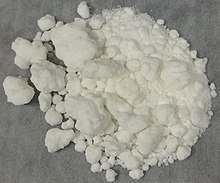
| |
| Names | |
|---|---|
Other names
| |
| Identifiers | |
3D model (JSmol)
|
|
| ChemSpider | |
| ECHA InfoCard | 100.040.109 |
| EC Number |
|
PubChem CID
|
|
CompTox Dashboard (EPA)
|
|
| |
| |
| Properties | |
| Yb(CH3COO)3 | |
| Appearance | crystal |
| soluble | |
| Hazards | |
| GHS labelling:[1] | |

| |
| Warning | |
| H315, H319, H335 | |
| P261, P264, P264+P265, P271, P280, P302+P352, P304+P340, P305+P351+P338, P319, P321, P332+P317, P337+P317, P362+P364, P403+P233, P405, P501 | |
| Related compounds | |
Other anions
|
Ytterbium(III) oxide Ytterbium(III) hydroxide Ytterbium(III) carbonate |
Other cations
|
Lutetium(III) acetate Thulium(III) acetate |
Except where otherwise noted, data are given for materials in their standard state (at 25 °C [77 °F], 100 kPa).
| |
Ytterbium(III) acetate is an inorganic salt of ytterbium and acetic acid, with a chemical formula of Yb(CH3COO)3. It has colorless crystals that are soluble in water and can form hydrates.[2][3]
- ^ "Ytterbium(3+) acetate". pubchem.ncbi.nlm.nih.gov. Retrieved 17 May 2022.
- ^ Редкол.: Никольский Б.П. и др., ed. (1971). Справочник химика. Vol. 2 (3-е изд., испр ed.). Л.: Химия.
- ^ CRC Handbook of Chemistry and Physics (89th ed.). Taylor and Francis Group, LLC. 2008.